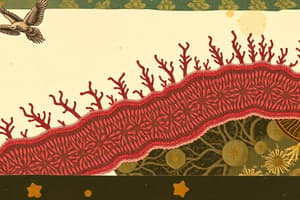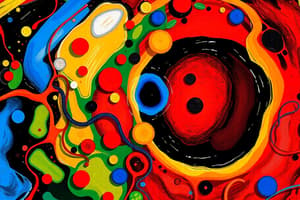Podcast
Questions and Answers
What is a significant property of water that enhances its interaction with various substances?
What is a significant property of water that enhances its interaction with various substances?
- Its viscosity
- Its unique nonpolar structure
- Its unique polar structure (correct)
- Its capability to repel hydrophilic substances
Which of the following is NOT a key concept for understanding biochemical processes?
Which of the following is NOT a key concept for understanding biochemical processes?
- Water
- Molecular biology (correct)
- Biological membranes
- Signal transduction
What type of structure do biological membranes primarily consist of?
What type of structure do biological membranes primarily consist of?
- Phospholipid bilayer (correct)
- Rigid protein layer
- Triple lipid layer
- Single lipid layer
Which statement best describes biological membranes?
Which statement best describes biological membranes?
What process allows the components of living organisms to spontaneously organize into functional structures?
What process allows the components of living organisms to spontaneously organize into functional structures?
Which component is crucial in the signal transduction process as a signaling device?
Which component is crucial in the signal transduction process as a signaling device?
Which statement is true regarding cells in the human body?
Which statement is true regarding cells in the human body?
What role do macromolecular crowding and proteostasis play in cells?
What role do macromolecular crowding and proteostasis play in cells?
What is the primary function of the membrane skeleton in eukaryotic cells?
What is the primary function of the membrane skeleton in eukaryotic cells?
Which of the following proteins is NOT mentioned as part of the membrane skeleton?
Which of the following proteins is NOT mentioned as part of the membrane skeleton?
How are peripheral proteins associated with the plasma membrane?
How are peripheral proteins associated with the plasma membrane?
What structural feature characterizes the plasma membrane in animal cells?
What structural feature characterizes the plasma membrane in animal cells?
What is the role of fibroblasts in higher animals?
What is the role of fibroblasts in higher animals?
Which of the following features is NOT common to all prokaryotes?
Which of the following features is NOT common to all prokaryotes?
What is the primary function of the prokaryotic cell wall?
What is the primary function of the prokaryotic cell wall?
What major component contributes to the strength of the prokaryotic cell wall?
What major component contributes to the strength of the prokaryotic cell wall?
Which statement about lipopolysaccharides is true?
Which statement about lipopolysaccharides is true?
In which type of bacteria are endotoxins typically found?
In which type of bacteria are endotoxins typically found?
What is the function of porins in the outer membrane of prokaryotic cells?
What is the function of porins in the outer membrane of prokaryotic cells?
Which of the following statements about prokaryotic cells is correct?
Which of the following statements about prokaryotic cells is correct?
How do the thickness and composition of a prokaryotic cell wall affect its interaction with dyes?
How do the thickness and composition of a prokaryotic cell wall affect its interaction with dyes?
What is the primary function of Rough ER?
What is the primary function of Rough ER?
What triggers ER stress?
What triggers ER stress?
Which of the following is NOT a function of Smooth ER?
Which of the following is NOT a function of Smooth ER?
What is the internal space of the Endoplasmic Reticulum called?
What is the internal space of the Endoplasmic Reticulum called?
Which factor is NOT a contributor to ER stress?
Which factor is NOT a contributor to ER stress?
What type of stress can result from the accumulation of misfolded proteins?
What type of stress can result from the accumulation of misfolded proteins?
Which function is specifically associated with the Rough ER over the Smooth ER?
Which function is specifically associated with the Rough ER over the Smooth ER?
Which condition can lead to metabolic stress impacting the ER?
Which condition can lead to metabolic stress impacting the ER?
What is the primary function of lysosomes in eukaryotic cells?
What is the primary function of lysosomes in eukaryotic cells?
Which component is NOT a part of the nucleus?
Which component is NOT a part of the nucleus?
What role do nuclear pore complexes play?
What role do nuclear pore complexes play?
Mitochondria are best known for being the site of what cellular process?
Mitochondria are best known for being the site of what cellular process?
Which feature is characteristic of mitochondria?
Which feature is characteristic of mitochondria?
What are mitochondria-associated membranes (MAMs)?
What are mitochondria-associated membranes (MAMs)?
What is the primary component contained within lysosomes?
What is the primary component contained within lysosomes?
Which of the following incorrectly describes the nuclear envelope?
Which of the following incorrectly describes the nuclear envelope?
Which is NOT a function of the nucleus?
Which is NOT a function of the nucleus?
Which of the following structures is found inside the nucleus?
Which of the following structures is found inside the nucleus?
Flashcards are hidden until you start studying
Study Notes
Cellular Basics
- Cells can sense, respond to their environment, transform matter and energy, and reproduce.
- Approximately 200 types of cells exist in the human body, each performing various functions while sharing fundamental characteristics.
- All cells possess a membrane that separates them from their surroundings and are composed of similar molecular structures.
Key Concepts in Biochemistry
- Understanding biochemical processes in a biological context involves these key themes:
- Water
- Biological membranes
- Self-assembly
- Molecular machines
- Macromolecular crowding
- Proteostasis
- Signal transduction, including calcium ions as signals and their relationship with metabolism.
Water
- Water has a unique polar structure and interacts with a diverse range of substances, making it essential for biological functions.
Biological Membranes
- Membranes are thin, flexible, stable structures that serve as selective barriers.
- Composed of a phospholipid bilayer, they contain integral and peripheral membrane proteins.
Self-Assembly
- Living organisms consist of supramolecular structures formed through self-assembly processes.
Prokaryotic Cells
- Prokaryotes encompass bacteria and archaea, characterized by:
- Common features: cell wall, plasma membranes, circular DNA, absence of membrane-bound organelles.
Prokaryotic Cell Wall
- The cell wall is a complex semi-rigid structure that provides support and protection, composed of peptidoglycan.
- The lipid outer membrane contains lipopolysaccharide, which acts as an endotoxin influencing symptoms in infections.
- Small molecules cross the outer membrane via porins.
Eukaryotic Cells Overview
- The plasma membrane consists of a lipid bilayer with various integral proteins embedded, offering mechanical strength and defining cell shape through a protein meshwork known as the membrane skeleton.
Endoplasmic Reticulum (ER)
- The ER consists of membranous tubules, vesicles, and flattened sacs containing the ER lumen.
- Rough ER is involved in protein synthesis, folding, and glycosylation, while Smooth ER focuses on lipid biosynthesis and calcium storage.
- ER stress occurs from the accumulation of misfolded polypeptides due to various environmental and genetic factors.
Lysosomes
- Lysosomes contain acid hydrolases, enzymes responsible for degrading cellular debris and participating in autophagy.
Nucleus
- The nucleus is the most prominent organelle, housing hereditary information and serving as the transcription site.
- Contains components like nucleoplasm, chromatin, nuclear matrix, nucleolus, and an envelope with nuclear pore complexes for molecular exchange.
Mitochondria
- Mitochondria serve as the site for aerobic metabolism and are the principal source of cellular energy.
- Composed of inner and outer membranes surrounding the matrix, they contain their own DNA and ribosomes.
- They form stable contact sites with the endoplasmic reticulum, known as mitochondria-associated membranes (MAMs).
Studying That Suits You
Use AI to generate personalized quizzes and flashcards to suit your learning preferences.




